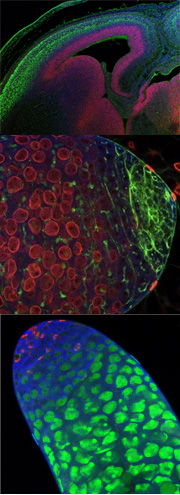
Research
|
|||
|
Our research is focused on understanding mechanisms underlying the coordinate regulation of growth control and cell polarity. Fat cadherins are conserved, extremely large cell-cell adhesion molecules (560kDa), that are responsible for integrating growth and the planar cell polarity (PCP) tissue organization pathway (reviewed in Sharma & McNeill, 2013). PCP is crucial to proper tissue function; its loss is responsible for a gamut of human diseases, including neural tube closure and cystic kidney disease. We have shown that in Drosophila, Fat cadherins restrict tissue growth via control of the Hippo pathway, a highly conserved kinase cascade, which has been shown to be misregulated in several human cancers and regulates PCP via the Atrophin nuclear co-receptor (Fanto et al., 2003; Silva et al, 2006). We use Drosophila as a genetically tractable organism to investigate the developmental control of tissue organization and growth. We combine this with biochemical analysis of Fat-cadherins in both Drosophila and tissue culture models, and explore the relevance of our finding to mammalian health with mouse models of Fat cadherins. These approaches have led to insight into downstream mechanisms for Fat function in PCP and growth control, and revealed new functions and mechanisms for the Hippo pathway. To determine if the function of Fat is conserved to mice, we generated conditional alleles for Fat4, the closest Fat homolog in mammals. We showed that loss of Fat4 leads to PCP defects in mice, demonstrating that the Fat-PCP pathway is conserved, and that loss of Fat4 leads to cystic kidney disease (Saburi et al., 2008). We extended our analysis to other Fat cadherins, and showed redundant function of Fat1 in repression of cystogenesis (Saburi et al, 2012). We collaborated with an international team to demonstrate that mutations in human FAT4 and its ligand DCHS1 lead to Van Maldergem syndrome (Capello et al, 2013). We showed Fat1 and Fat4 synergistically regulate neural stem proliferation and migration in the mouse brain (Badouel et al, 2015). Exploring how the Hippo pathway interacts with Fat4, we discovered that YAP activity is regulated by CDC42, directing nephron morphogenesis and stem cell fate (Reginensi et al., 2013), and disruptions of the Hippo pathway lead to defects in kidney development (Reginensi et al, 2015). We also showed that Fat4 and Dchs1 regulate nephron progenitor pool size (Bagherie-Lachidan et al., 2015). However, although it is now clear that disruptions of Fat cadherins and the Hippo pathway have critical roles in human diseases, it is poorly understood how to treat these diseases. For this we need to better understand the biology of Fat cadherin signaling, and how Fat and other upstream pathway components regulate the Hippo pathway. We will use a combination of genetic, molecular and biochemical approaches to understand how growth control and tissue organization is regulated by Fat cadherins and the Hippo pathway. We are studying this pathway in flies, mice and hydra to understand the wiring of the Fat pathway- and we feel that this broad approach provides unexpected insights into basic mechanisms, and exceptional training for PhD and Postdoctoral fellows in the lab.
Fat regulation of GrowthGrowth control by the Drosophila tumour suppressor gene fat. Genetic studies have demonstrated fat is critical regulator of growth upstream of the Hippo pathway in flies Studies in our lab are addressing how Fat regulates the Hippo pathway in Drosophila, and if this regulation is conserved to humans.
Fat regulation of Planar PolarityA central problem in cell and developmental biology is understanding how cells and groups of cells become organized into higher order structures. Fat regulates a form of tissue organization known as Planar Cell Polarity (PCP). We are investigating how Fat controls PCP upstream of the transcriptional co-repressor Atrophin. We are also using biochemical and genetic screens to find new elements of the Fat-PCP pathway.
Past WorkWe have studied PCP and cell polarity in Drosophila in diverse pathways in the past. Specific areas of interest include Mirror, TSC and LKB1. |
|||
 |
|||